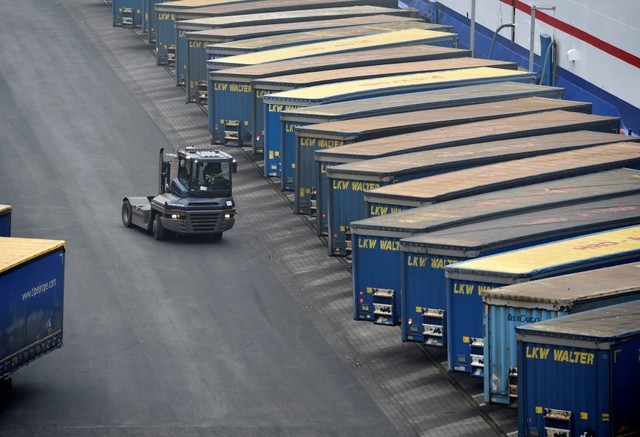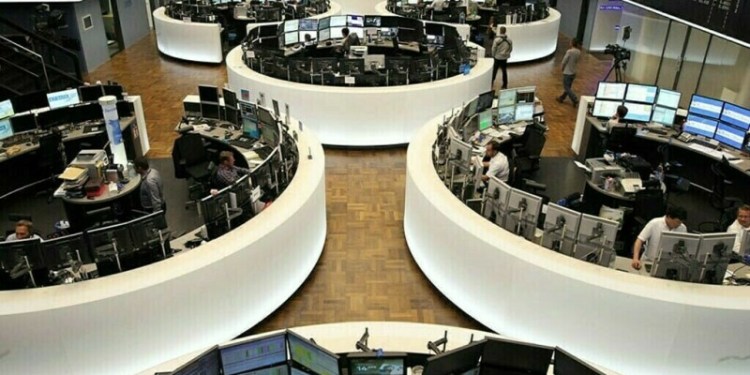 © Reuters. FILE PHOTO: Containers are pictured at a loading terminal in the port of Kiel
© Reuters. FILE PHOTO: Containers are pictured at a loading terminal in the port of KielBy Padraic Halpin
DUBLIN (Reuters) – While German politics may dominate the headlines again in the coming week, the less attention grabbing release of industrial data could offer a better indication of the headwinds facing the European Union and its largest economy.
With fears of a trade war rattling markets as U.S. President Donald Trump’ “America First” policies become more of a reality and his protectionist sights turn to the EU, many will look to Germany’s export-oriented economy for the first signs of stress.
German industrial orders for May are published on Thursday after they plunged a month earlier, marking a fourth straight monthly drop as growing uncertainty about global trade led companies to scale back investment plans.
While a Reuters poll of analysts predicts order will bounce back and expand by 1.1 percent, respondents had anticipated a 0.8 percent rise in April before the index fell by 2.5 percent.
German industrial output for the month is released a day later and analysts at DZ Bank expect the overall trend to reflect the prevailing international headwinds facing Germany.
“We do not expect the May data to show that the figures have turned around,” DZ Bank’s Christine Schaefer wrote in a note, naming the industrial data as one of the week’s two top global indicators alongside the latest U.S. labor market report.
“While order receipts have probably improved on the month, this will primarily be the result of a correction after a very poor April figure. As regards industrial output, we assume that there will be another, albeit minor decrease.”
“In other words, the deterioration in international conditions continues to dampen activity in German industry.”
FED MINUTES
By the time the industrial data is released – or even the latest PMI survey of German manufacturers on Monday – markets should have a firm idea of whether a new EU migration deal has handed German Chancellor Angela Merkel some temporary respite.
Merkel’s allies, the Christian Social Union (CSU), gave her until the end of this week’s EU summit to agree the new policies and they looked to have mollified her restless partners ahead of a meeting on Sunday to take a definitive decision.
Yet even if that respite does turn out to be just momentary, trade and not politics will continue to dictate whether the upswing in the world’s number four economy is losing further momentum.
“Although businesses don’t relish uncertainty, the consequences for the economy would probably be limited if the alliance between the CDU and the CSU broke up,” Commerzbank (DE:) chief economist Joerg Kraemer said.
With minutes from the Federal Reserve’s last policy meeting published on Thursday, the June employment report due a day later will add the latest piece to the puzzle facing the Fed as it debates how much further to raise interest rates during a continued economic expansion.
After dropping to an 18-month low of 3.8 percent in May – already below what Fed officials consider “full employment” – economists polled by Reuters see the unemployment rate staying put in June, though some predict the potential for a surprise.
“This week we will see more evidence of the excellent performance of the economy with the key business surveys remaining at elevated levels and the U.S. economy continuing to add jobs in significant numbers,” analysts at ING wrote in a note.
“There is an outside chance the unemployment rate falls to a new 50-year low of 3.7 percent while the annual rate of wage growth could tick up to 2.8 percent.”
Fusion Media or anyone involved with Fusion Media will not accept any liability for loss or damage as a result of reliance on the information including data, quotes, charts and buy/sell signals contained within this website. Please be fully informed regarding the risks and costs associated with trading the financial markets, it is one of the riskiest investment forms possible.
Source: Investing.com



























